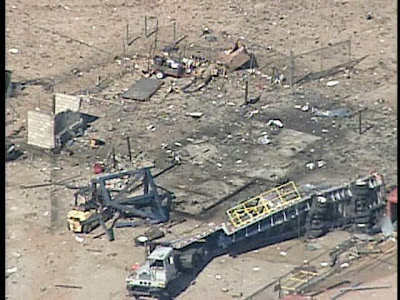
NASA Ames is holding a conference to discuss the sending of robotic and potentially manned missions to the moons of Mars. The
conference which is being called "PhobosDeimos2007" will be held at the NASA Ames Research Center's
conference facility from November 5th through 8th of 2007. Tickets for professionals are $150 if ordered early and $195 at the door. Students are only $75 and the working press is free. Sadly, I fall into neither one of the last two categories. One of the special events at the conference is a presentation about the proposed/upcoming ESA/Russian mission to phobos called
Phobos-Grunt, a sample-return mission from Phobos.
Unlike a sample-return mission to Mars proper, the mission to Phobos should be relatively "easy" (i. e. "not impossible"). With a surface gravity between 860 and 190 microgravities (less than 1% of earth normal) and an escape velocity of 39 km/hr, landing and leaving the microplanet should be no problem even with satellite calibre thrusters. Of course, with the ESA running the program, expect to see mostly pictures and movies of smiling managers congratulating each other and perhaps one or two grainy pictures of the Phobos itself (Sorry, this last comment reflects my disappointment with the Huygen's probe media coverage :P ).
Here are some ideas explorers of
Thuria and Cluros might want to consider:
(1) The surface of Phobos (and presumably Deimos) is covered with a 1 meter layer of fine dust. The potential challenge here would be that firing landing rockets near the surface is likely to dig a deep pit or obscure the landing area or cover everything with dust in the immediate area, such as the probe's solar panels. A different approach might be to drop the last 50 meters or so onto the surface. If the probe's velocity was reduced to a stand still 50 meters above Phobos and then the probe was allowed to fall, it would hit the surface about 6 minutes later at an "impact" velocity of something around 1 foot per second. Springs/shock absorbers in the landing gear could easily absorb that impact. Which brings up another point. One might be able to design a probe with "
springtail" or pogo-stick landing gear to provide propellantless flight to various parts of Phobos. During landing, the springs in the landing gear would compress and store energy for later lift off.
(2) Since martian meteors have been found on Earth with relative ease and since Phobos and Deimos are much closer to Mars than Earth is, it might be worthwhile to search for Mars meteors on Phobos and Deimos. This would be a cheesy way of performing a Mars sample-return mission. At least it wouldn't hurt to take a look around.
(3)Hopefully, whatever goes to Phobos and Deimos is carrying a fairly significant geologic lab. And while we're at it, looking for water and other hydrocarbons is pretty important too. Ground penetrating radar might be good for general hydrocarbon dowsing. Water and hydrocarbons, of course, provide the potential return fuel for future missions to the red planet, as I mentioned in my previous post "
Riding Dog Bones and Doughnuts to Mars and Beyond".
That's it from me for now. Feel free to add your own thoughts to the blog.







